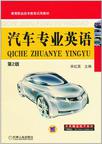汽车专业英语
出版时间:2009-8 出版社:机械工业出版社 作者:宋红英 编 页数:199 字数:315000
前言
《汽车专业英语》最初于2003年出版,经过6年多的使用,得到了高职高专院校师生的广泛认可。但是,随着汽车技术、高职教育和岗位需求的变化,原版教材在内容选取、编写体例和教学目标等方面已经不能满足教学要求,因此,在机械工业出版社的大力支持下,教材编写组克服时间紧、任务重等难题,在原有基础上,积极探索、锐意创新,对原版教材做了大幅度的修订。 新版教材更新了绝大部分内容,使其更符合高职教育要求,更贴近岗位工作需要。本书的整体构思借鉴了国内外先进的职业教育理念,突出“学生主体,能力本位,任务载体”的工作过程导向课程开发原则。以学习者为中心,根据高职学生及其职业特点,设定课程学习目标,按照学习者获取职业英语技能的需求,用灵活多样的任务形式组织教学内容,便于教师实施各种高效的教学方法和手段,实现预期的教学目标。 本书内容的选取突出以“学习者为中心、语用为中心、技能为中心”的职场英语课程特征,符合能力本位的职业教育需求;以汽车职业交流用语、汽车技术应用用语、汽车职业实务用语为核心,采用与公共英语不同的能力鉴定理念和方法,创设仿真的语用环境,提高学习者的英语综合应用能力,巩固学习效果和效用。 本书共八个单元。第一、二、三、四单元是以汽车构造为主,涵盖了发动机、底盘及电气设备等内容,所有素材均选自英文原文,体例编排图文并茂,便于识读、理解、记忆和灵活运用;第五单元为汽车销售和售后服务用语,主要介绍客户接待、车款推介、价格商谈、维修接待等常用英语,旨在提高学习者的口语交流能力;第六单元为实用会话,是在第五单元的基础上,模拟真实的职场情境,力求提高学习者的职场英语实战能力;第七单元为常见汽车标识,主要介绍汽车标牌及VIN代码的含义;第八单元为OBD一Ⅱ故障码的中英文对照。 每个单元都配有词汇表、课文注释、阅读材料和实用性很强的练习题,便于学生复习、巩固和提高。这些练习题不但对课文内容有很好的针对性,而且还提供了口语交流、资料翻译等工作岗位必需的技能训练题目,增强了内容的实用性,是本书的一大亮点。书后附有专业词汇表和常用缩略语表,便于学生自学和实际工作中查阅。 本书是高等职业技术院校汽车专业的教学用书,也可作为相关行业岗位培训或自学用书,同时可供汽车维修人员学习参考。 本书由邢台职业技术学院宋红英任主编,侯江丽、何宝文任副主编。其中,第一、二、八单元由侯江丽、宋红英、胡利平编写,第三单元由刘学明、宋红英编写,第四单元由何宝文编写,第五、七单元由胡慧敏、宋红英编写,第六单元由宋红英、刘学明编写,附录I、Ⅱ由胡利平、侯江丽编写。 由于作者水平有限,疏漏和错误之处在所难免,敬请读者予以斧正。
内容概要
本书共八个单元。第一、二、三、四单元以汽车构造为主,介绍发动机、底盘及电气设备等内容;第五单元为汽车销售和售后服务用语,主要介绍客户接待、车款推介、价格商谈、维修接待等常用英语;第六单元为实用会话,模拟真实的职场情境;第七单元为常见汽车标识,主要介绍汽车标牌及VIN代码的含义;第八单元为OBD—Ⅱ故障码的中英文对照。 本书内容安排合理、条理清晰,符合高职教育要求和岗位工作需要,适合高等职业技术院校汽车专业英语教学使用,也可作为相关行业岗位培训或自学用书,同时可供汽车维修人员学习参考。
书籍目录
前言Unit One Brief Introduction of AutomobileUnit Two Engine System 2.1 Main Components of Engine 2.2 Cylinder Block and Cylinder Head 2.3 Piston and Connecting Rod 2.4 Crankshaft and Flywheel 2.5 Valve Gear 2.6 Cooling System 2.7 Lubrication System 2.8 Electronic Fuel Injection System 2.9 Emission Control System 2.10 Intake and Exhaust SystemsUnit Three Chassis 3.1 Drive Line 3.2 Clutch 3.3 Manual Transmission 3.4 Automatic Transmission 3.5 Final Drive 3.6 Universal Drive 3.7 Running Gear 3.8 The Steering System 3.9 Braking SystemUnit Four Electrical Equipment 4.1 Charging System 4.2 Starting System 4.3 Ignition System Basics 4.4 Electronic Ignition System 4.5 Air Bag System 4.6 Air ConditioningUnit Five Automobile Sales and After Service 5.1 Greetings 5.2 Introduction of New Models 5.3 Negotiation of Price 5.4 Terms of Payment 5.5 Appointment 5.6 Maintenance Reception 5.7 Users' Feedback 5.8 Reply for Customers' ComplaintsUnit Six Practical Conversation 6.1 Receiving Customers 6.2 Inquiry 6.3 Automatic Transmission and Manual Transmission 6.4 Suspension System 6.5 Automobile ABS 6.6 Automobile Noise and Vibration 6.7 Hybrid Car 6.8 GPS Navigation SystemUnit Seven Common English Identifier of Imported Vehicles 7.1 Marks of VehicIe Model 7.2 Vehicle Identification Number (VIN) Unit Eight OBD- II DTC 8.1 OBD- II DTC Summarization 8.2 Explanation of DTCAppendix Appendix I Vocabulary Appendix II AbbreviationsReferences (参考文献)
章节摘录
Camshaft s function is to open the engine valves posi-tively and timely, in a definite sequence, and to control theirclosing against the return action of the valve springs. Theshaft is made integral with its cams and bearing journals.Each cam controls a single valve, either intake or exhaust. Insome automobile engines, the camshaft is made integral withfuel pump eccentric wheel and oil pump drive gear. Thecamshaft bearings are lubricated with oil supplied under pres-sure from the main gallery in the cylinder block. The tappets serve to transmit the force from the camshaftto the push rods. The tappets are small cylindrical bores re-ceiving the push rods. They are made of cast iron or steeland located in the guides, which may be made integral withthe cylinder block or removable as in the engine. When theengines operate, the tappets continuously rotate about theiraxes for uniform wear. The rotation is ensured by a convexsurface of their bottoms and a slanted surface of the cams. The push rods transmit the force from the tappets to the rocker. They usually have small con-vex balls inserted on each of their ends. These convex bails fit into the tappet and rocker arm toallow proper movement. Overhead camshafts do not need the push rod. Rocker arms are designed to change the direction of the cam lifting force and provide a cer-tain mechanical advantage during valve lifting. The purpose of the mechanical advantage is toopen the valve more than the actual lift of the camshaft lobe, which can be done by changing thedistance from the pivot point to the end of the rocker ann. There is the valve clearance betweenthe rocker contact pad and the valve stem tip, so that the valve will be tightly pressed against itsseat when hot. The clearance can be adjusted by adjusting screw of the rocker arm. Each cylinder of a four-stroke-cycle diesel or gasoline engine is commonly equipped with anintake valve and an exhaust valve. The purpose of the intake valve is to allow the air fuel mixtureor air to enter the cylinder. After the combustion process has been completed, the burned gasesare permitted to escape from the cylinder through the exhaust valve. The differences of the intakeand exhaust valves are of different diameter. For better engine breathing, the intake valve has alarger diameter than the exhaust one. To obtain sufficient valve area, some automobiles have twointake valves and two exhaust valves. A valve consists of a head and stem. The valve head has a narrow chamfer of 45~or 30~re-ferred to as valve face. The valve face fits tightly against the seat, which is achieved by grinding. Valve seats are defined as circular surfaces that are machined into the cylinder block or head.The seats provide a surface for the intake and exhaust valves to seal for gas leakage. The seats alsohelp to dissipate the heat built up in the valve.
图书封面
评论、评分、阅读与下载
用户评论 (总计1条)
- 书比想象薄
有看的话,收获绝对不止十几块吧。
推荐图书
- 寻找投资护城河
- 篁破幻草子之平安退魔录
- 健康怀孕百科专家指导版
- 死囚的伊甸园
- 长征秘闻
- 初中语文·语文版·七年级(上)
- うるし原智志ビジュアルワークス~フロントイノセントvol.1より~ (大型本)
- 每天3小时冲刺雅思听力
- 囧蛙糗事
- 动物文化小品集
- 猫でもわかるWindowsプログラミング第3版
- 我爱喵喵喵
- 我们是雇佣兵
- 黎鲁自行车速写上海
- 广西仫佬族社会历史调查
- 云南少数民族社会历史调查资料汇编
- 景颇族社会历史调查
- 布朗族社会历史调查
- 广西彝族仡佬族水族社会历史调查
- 民主主義論
- 10全能学练达标练测100分*二年级语文下*语S
- 晚清尽头是民国
- ハンス・ケルゼン自伝
- 汉语语法理论研究
- 悪魔の水槽密室
